Zeren Sun
Knowledge Transfer with Simulated Inter-Image Erasing for Weakly Supervised Semantic Segmentation
Jul 03, 2024Abstract:Though adversarial erasing has prevailed in weakly supervised semantic segmentation to help activate integral object regions, existing approaches still suffer from the dilemma of under-activation and over-expansion due to the difficulty in determining when to stop erasing. In this paper, we propose a \textbf{K}nowledge \textbf{T}ransfer with \textbf{S}imulated Inter-Image \textbf{E}rasing (KTSE) approach for weakly supervised semantic segmentation to alleviate the above problem. In contrast to existing erasing-based methods that remove the discriminative part for more object discovery, we propose a simulated inter-image erasing scenario to weaken the original activation by introducing extra object information. Then, object knowledge is transferred from the anchor image to the consequent less activated localization map to strengthen network localization ability. Considering the adopted bidirectional alignment will also weaken the anchor image activation if appropriate constraints are missing, we propose a self-supervised regularization module to maintain the reliable activation in discriminative regions and improve the inter-class object boundary recognition for complex images with multiple categories of objects. In addition, we resort to intra-image erasing and propose a multi-granularity alignment module to gently enlarge the object activation to boost the object knowledge transfer. Extensive experiments and ablation studies on PASCAL VOC 2012 and COCO datasets demonstrate the superiority of our proposed approach. Source codes and models are available at https://github.com/NUST-Machine-Intelligence-Laboratory/KTSE.
Foster Adaptivity and Balance in Learning with Noisy Labels
Jul 03, 2024Abstract:Label noise is ubiquitous in real-world scenarios, posing a practical challenge to supervised models due to its effect in hurting the generalization performance of deep neural networks. Existing methods primarily employ the sample selection paradigm and usually rely on dataset-dependent prior knowledge (\eg, a pre-defined threshold) to cope with label noise, inevitably degrading the adaptivity. Moreover, existing methods tend to neglect the class balance in selecting samples, leading to biased model performance. To this end, we propose a simple yet effective approach named \textbf{SED} to deal with label noise in a \textbf{S}elf-adaptiv\textbf{E} and class-balance\textbf{D} manner. Specifically, we first design a novel sample selection strategy to empower self-adaptivity and class balance when identifying clean and noisy data. A mean-teacher model is then employed to correct labels of noisy samples. Subsequently, we propose a self-adaptive and class-balanced sample re-weighting mechanism to assign different weights to detected noisy samples. Finally, we additionally employ consistency regularization on selected clean samples to improve model generalization performance. Extensive experimental results on synthetic and real-world datasets demonstrate the effectiveness and superiority of our proposed method. The source code has been made available at https://github.com/NUST-Machine-Intelligence-Laboratory/SED.
Relating CNN-Transformer Fusion Network for Change Detection
Jul 03, 2024



Abstract:While deep learning, particularly convolutional neural networks (CNNs), has revolutionized remote sensing (RS) change detection (CD), existing approaches often miss crucial features due to neglecting global context and incomplete change learning. Additionally, transformer networks struggle with low-level details. RCTNet addresses these limitations by introducing \textbf{(1)} an early fusion backbone to exploit both spatial and temporal features early on, \textbf{(2)} a Cross-Stage Aggregation (CSA) module for enhanced temporal representation, \textbf{(3)} a Multi-Scale Feature Fusion (MSF) module for enriched feature extraction in the decoder, and \textbf{(4)} an Efficient Self-deciphering Attention (ESA) module utilizing transformers to capture global information and fine-grained details for accurate change detection. Extensive experiments demonstrate RCTNet's clear superiority over traditional RS image CD methods, showing significant improvement and an optimal balance between accuracy and computational cost.
Poly Kernel Inception Network for Remote Sensing Detection
Mar 20, 2024Abstract:Object detection in remote sensing images (RSIs) often suffers from several increasing challenges, including the large variation in object scales and the diverse-ranging context. Prior methods tried to address these challenges by expanding the spatial receptive field of the backbone, either through large-kernel convolution or dilated convolution. However, the former typically introduces considerable background noise, while the latter risks generating overly sparse feature representations. In this paper, we introduce the Poly Kernel Inception Network (PKINet) to handle the above challenges. PKINet employs multi-scale convolution kernels without dilation to extract object features of varying scales and capture local context. In addition, a Context Anchor Attention (CAA) module is introduced in parallel to capture long-range contextual information. These two components work jointly to advance the performance of PKINet on four challenging remote sensing detection benchmarks, namely DOTA-v1.0, DOTA-v1.5, HRSC2016, and DIOR-R.
VideoMAC: Video Masked Autoencoders Meet ConvNets
Feb 29, 2024Abstract:Recently, the advancement of self-supervised learning techniques, like masked autoencoders (MAE), has greatly influenced visual representation learning for images and videos. Nevertheless, it is worth noting that the predominant approaches in existing masked image / video modeling rely excessively on resource-intensive vision transformers (ViTs) as the feature encoder. In this paper, we propose a new approach termed as \textbf{VideoMAC}, which combines video masked autoencoders with resource-friendly ConvNets. Specifically, VideoMAC employs symmetric masking on randomly sampled pairs of video frames. To prevent the issue of mask pattern dissipation, we utilize ConvNets which are implemented with sparse convolutional operators as encoders. Simultaneously, we present a simple yet effective masked video modeling (MVM) approach, a dual encoder architecture comprising an online encoder and an exponential moving average target encoder, aimed to facilitate inter-frame reconstruction consistency in videos. Additionally, we demonstrate that VideoMAC, empowering classical (ResNet) / modern (ConvNeXt) convolutional encoders to harness the benefits of MVM, outperforms ViT-based approaches on downstream tasks, including video object segmentation (+\textbf{5.2\%} / \textbf{6.4\%} $\mathcal{J}\&\mathcal{F}$), body part propagation (+\textbf{6.3\%} / \textbf{3.1\%} mIoU), and human pose tracking (+\textbf{10.2\%} / \textbf{11.1\%} PCK@0.1).
Learning with Imbalanced Noisy Data by Preventing Bias in Sample Selection
Feb 17, 2024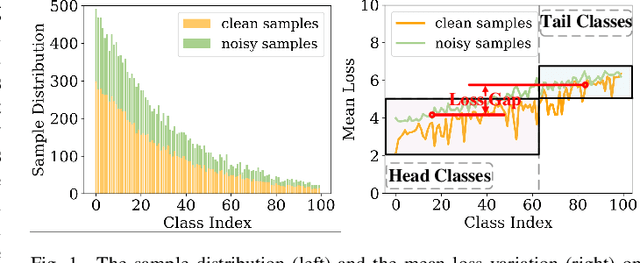
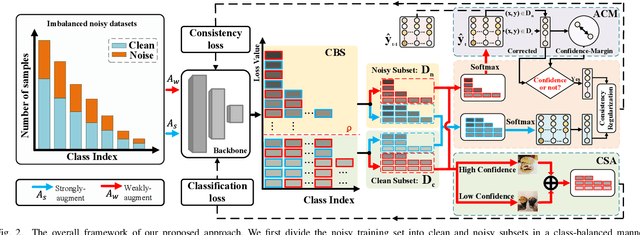
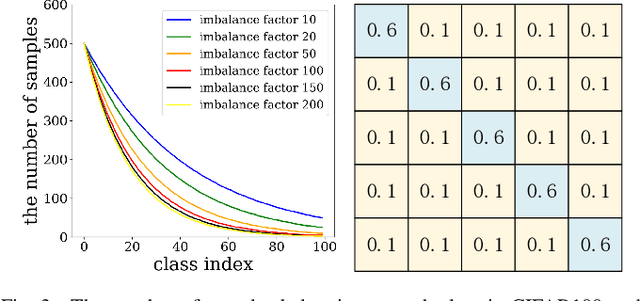

Abstract:Learning with noisy labels has gained increasing attention because the inevitable imperfect labels in real-world scenarios can substantially hurt the deep model performance. Recent studies tend to regard low-loss samples as clean ones and discard high-loss ones to alleviate the negative impact of noisy labels. However, real-world datasets contain not only noisy labels but also class imbalance. The imbalance issue is prone to causing failure in the loss-based sample selection since the under-learning of tail classes also leans to produce high losses. To this end, we propose a simple yet effective method to address noisy labels in imbalanced datasets. Specifically, we propose Class-Balance-based sample Selection (CBS) to prevent the tail class samples from being neglected during training. We propose Confidence-based Sample Augmentation (CSA) for the chosen clean samples to enhance their reliability in the training process. To exploit selected noisy samples, we resort to prediction history to rectify labels of noisy samples. Moreover, we introduce the Average Confidence Margin (ACM) metric to measure the quality of corrected labels by leveraging the model's evolving training dynamics, thereby ensuring that low-quality corrected noisy samples are appropriately masked out. Lastly, consistency regularization is imposed on filtered label-corrected noisy samples to boost model performance. Comprehensive experimental results on synthetic and real-world datasets demonstrate the effectiveness and superiority of our proposed method, especially in imbalanced scenarios. Comprehensive experimental results on synthetic and real-world datasets demonstrate the effectiveness and superiority of our proposed method, especially in imbalanced scenarios.
Adaptive Integration of Partial Label Learning and Negative Learning for Enhanced Noisy Label Learning
Dec 15, 2023



Abstract:There has been significant attention devoted to the effectiveness of various domains, such as semi-supervised learning, contrastive learning, and meta-learning, in enhancing the performance of methods for noisy label learning (NLL) tasks. However, most existing methods still depend on prior assumptions regarding clean samples amidst different sources of noise (\eg, a pre-defined drop rate or a small subset of clean samples). In this paper, we propose a simple yet powerful idea called \textbf{NPN}, which revolutionizes \textbf{N}oisy label learning by integrating \textbf{P}artial label learning (PLL) and \textbf{N}egative learning (NL). Toward this goal, we initially decompose the given label space adaptively into the candidate and complementary labels, thereby establishing the conditions for PLL and NL. We propose two adaptive data-driven paradigms of label disambiguation for PLL: hard disambiguation and soft disambiguation. Furthermore, we generate reliable complementary labels using all non-candidate labels for NL to enhance model robustness through indirect supervision. To maintain label reliability during the later stage of model training, we introduce a consistency regularization term that encourages agreement between the outputs of multiple augmentations. Experiments conducted on both synthetically corrupted and real-world noisy datasets demonstrate the superiority of NPN compared to other state-of-the-art (SOTA) methods. The source code has been made available at {\color{purple}{\url{https://github.com/NUST-Machine-Intelligence-Laboratory/NPN}}}.
Attention Map Guided Transformer Pruning for Edge Device
Apr 04, 2023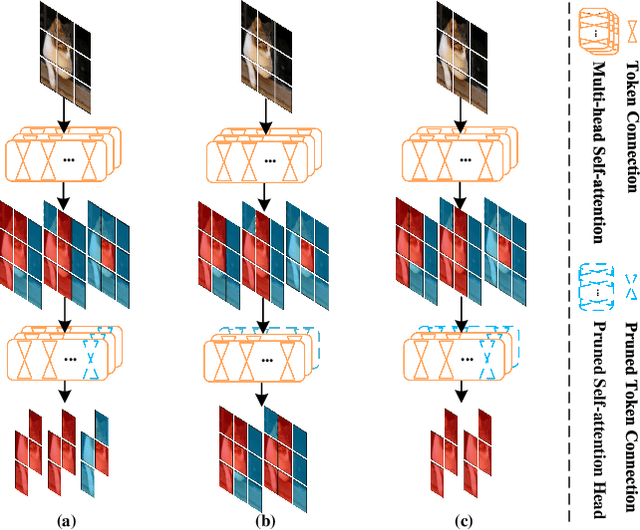
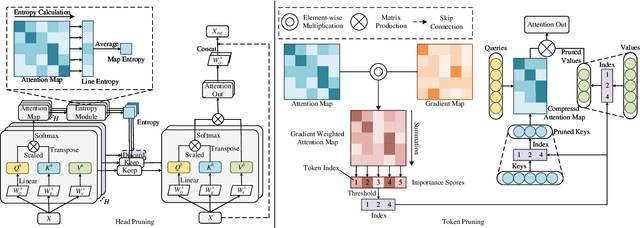
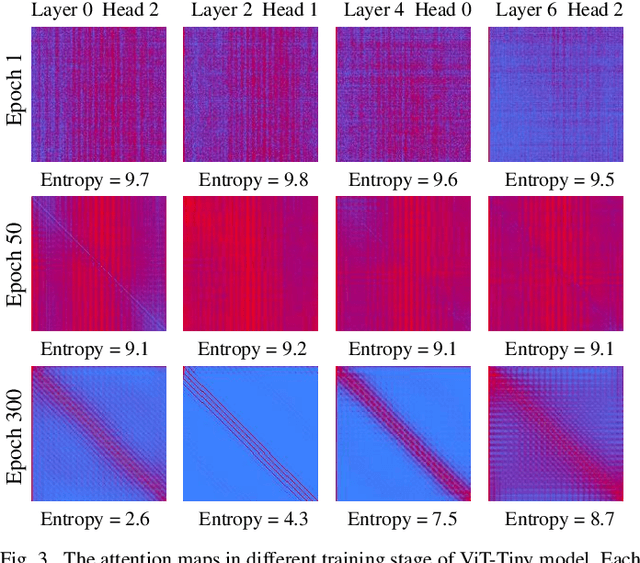

Abstract:Due to its significant capability of modeling long-range dependencies, vision transformer (ViT) has achieved promising success in both holistic and occluded person re-identification (Re-ID) tasks. However, the inherent problems of transformers such as the huge computational cost and memory footprint are still two unsolved issues that will block the deployment of ViT based person Re-ID models on resource-limited edge devices. Our goal is to reduce both the inference complexity and model size without sacrificing the comparable accuracy on person Re-ID, especially for tasks with occlusion. To this end, we propose a novel attention map guided (AMG) transformer pruning method, which removes both redundant tokens and heads with the guidance of the attention map in a hardware-friendly way. We first calculate the entropy in the key dimension and sum it up for the whole map, and the corresponding head parameters of maps with high entropy will be removed for model size reduction. Then we combine the similarity and first-order gradients of key tokens along the query dimension for token importance estimation and remove redundant key and value tokens to further reduce the inference complexity. Comprehensive experiments on Occluded DukeMTMC and Market-1501 demonstrate the effectiveness of our proposals. For example, our proposed pruning strategy on ViT-Base enjoys \textup{\textbf{29.4\%}} \textup{\textbf{FLOPs}} savings with \textup{\textbf{0.2\%}} drop on Rank-1 and \textup{\textbf{0.4\%}} improvement on mAP, respectively.
Webly Supervised Fine-Grained Recognition: Benchmark Datasets and An Approach
Aug 11, 2021
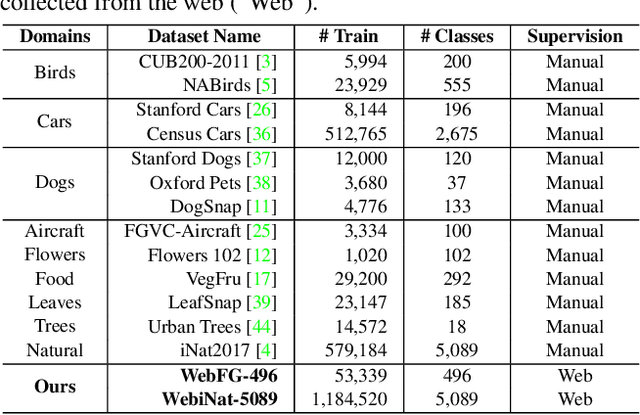

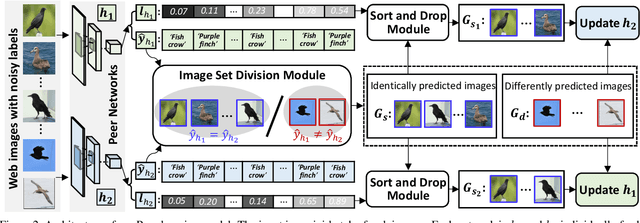
Abstract:Learning from the web can ease the extreme dependence of deep learning on large-scale manually labeled datasets. Especially for fine-grained recognition, which targets at distinguishing subordinate categories, it will significantly reduce the labeling costs by leveraging free web data. Despite its significant practical and research value, the webly supervised fine-grained recognition problem is not extensively studied in the computer vision community, largely due to the lack of high-quality datasets. To fill this gap, in this paper we construct two new benchmark webly supervised fine-grained datasets, termed WebFG-496 and WebiNat-5089, respectively. In concretely, WebFG-496 consists of three sub-datasets containing a total of 53,339 web training images with 200 species of birds (Web-bird), 100 types of aircrafts (Web-aircraft), and 196 models of cars (Web-car). For WebiNat-5089, it contains 5089 sub-categories and more than 1.1 million web training images, which is the largest webly supervised fine-grained dataset ever. As a minor contribution, we also propose a novel webly supervised method (termed "{Peer-learning}") for benchmarking these datasets.~Comprehensive experimental results and analyses on two new benchmark datasets demonstrate that the proposed method achieves superior performance over the competing baseline models and states-of-the-art. Our benchmark datasets and the source codes of Peer-learning have been made available at {\url{https://github.com/NUST-Machine-Intelligence-Laboratory/weblyFG-dataset}}.
Jo-SRC: A Contrastive Approach for Combating Noisy Labels
Mar 24, 2021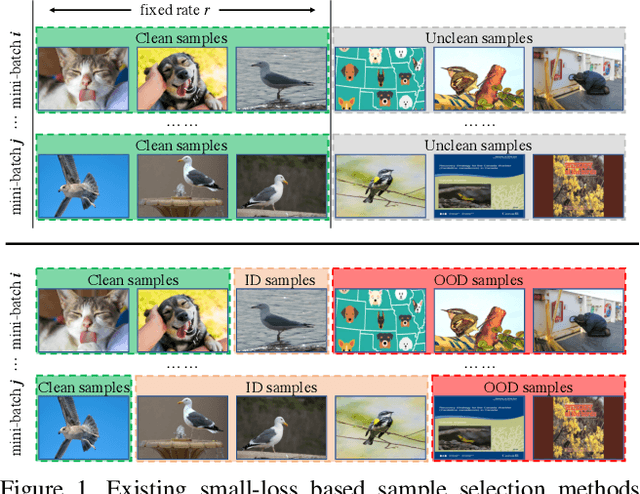

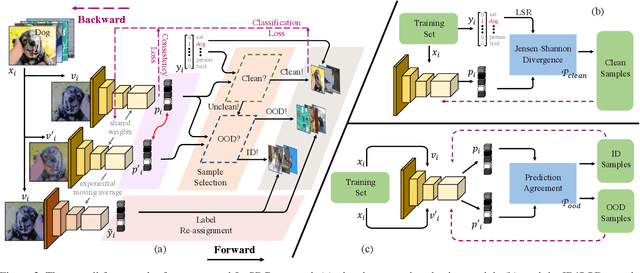

Abstract:Due to the memorization effect in Deep Neural Networks (DNNs), training with noisy labels usually results in inferior model performance. Existing state-of-the-art methods primarily adopt a sample selection strategy, which selects small-loss samples for subsequent training. However, prior literature tends to perform sample selection within each mini-batch, neglecting the imbalance of noise ratios in different mini-batches. Moreover, valuable knowledge within high-loss samples is wasted. To this end, we propose a noise-robust approach named Jo-SRC (Joint Sample Selection and Model Regularization based on Consistency). Specifically, we train the network in a contrastive learning manner. Predictions from two different views of each sample are used to estimate its "likelihood" of being clean or out-of-distribution. Furthermore, we propose a joint loss to advance the model generalization performance by introducing consistency regularization. Extensive experiments have validated the superiority of our approach over existing state-of-the-art methods.
 Add to Chrome
Add to Chrome Add to Firefox
Add to Firefox Add to Edge
Add to Edge